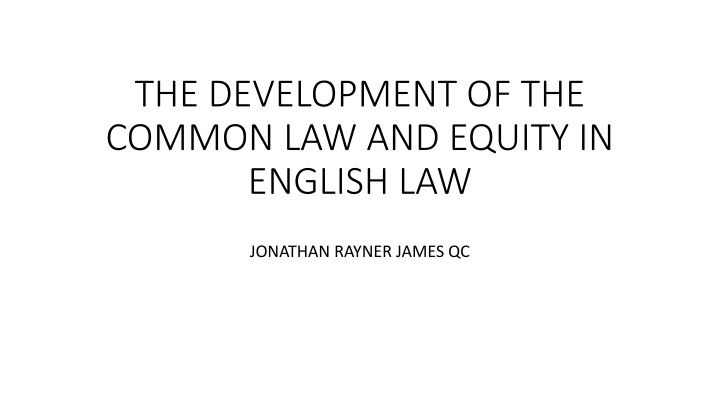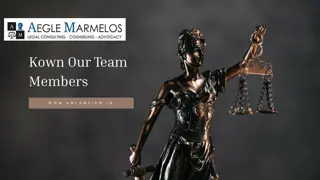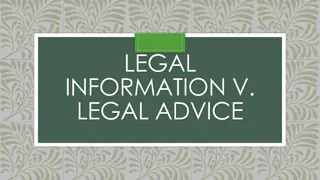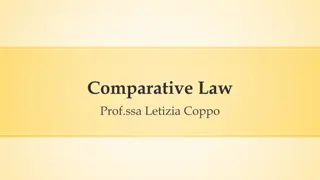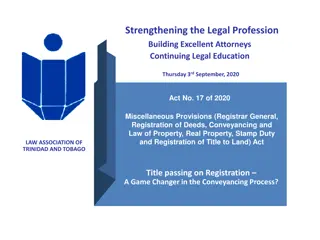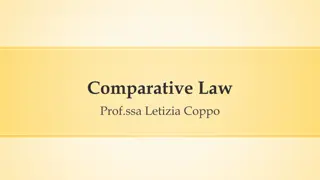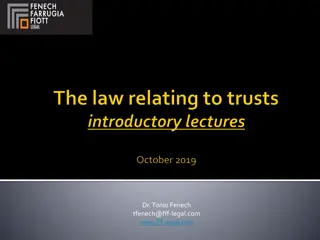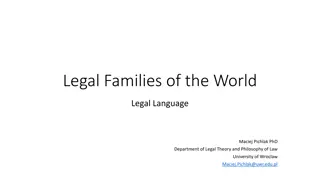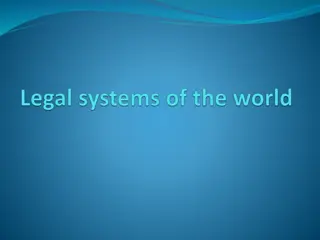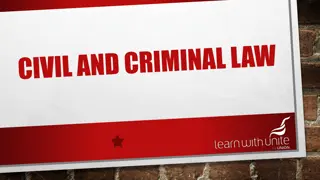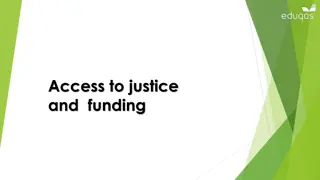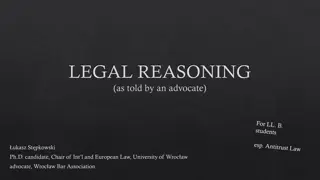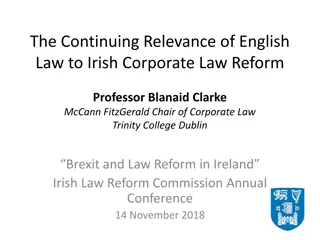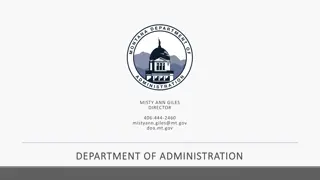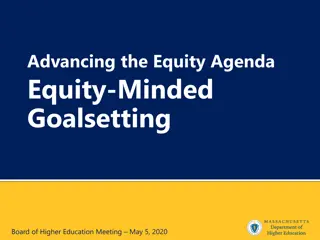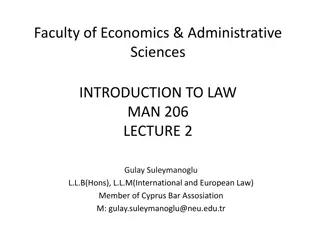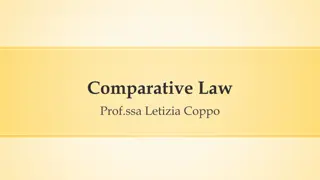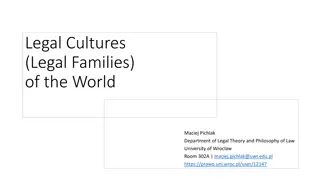Evolution of Common Law and Equity in English Legal System
Explore the development of common law and equity in English law, emphasizing the importance of adapting to societal changes for effective justice administration. Insights are drawn from historical figures like Francis Bacon and fundamental legal system elements. The lectures highlight the need for fair dispute resolution based on established legal principles, ensuring justice for all parties involved.
Download Presentation

Please find below an Image/Link to download the presentation.
The content on the website is provided AS IS for your information and personal use only. It may not be sold, licensed, or shared on other websites without obtaining consent from the author.If you encounter any issues during the download, it is possible that the publisher has removed the file from their server.
You are allowed to download the files provided on this website for personal or commercial use, subject to the condition that they are used lawfully. All files are the property of their respective owners.
The content on the website is provided AS IS for your information and personal use only. It may not be sold, licensed, or shared on other websites without obtaining consent from the author.
E N D
Presentation Transcript
THE DEVELOPMENT OF THE COMMON LAW AND EQUITY IN ENGLISH LAW JONATHAN RAYNER JAMES QC
PART I THE DEVELOPMENT OF THE COMMON LAW
AIM OF THESE LECTURES To demonstrate that a legal system which does not continuously adapt to meet the changing needs of its society will fail to meet the fundamental requirements of an effective administration of justice To demonstrate that those concerned with the administration of justice must be alert to ensure that self interest of individuals is not allowed to distort or undermine the administration of justice
FRANCIS BACON 1561-1625 LORD CHANCELLOR 1618-1621 He that will not apply new remedies must expect new evils; for time is the great innovator Essay Of Innovations written in 1625
INTRODUCTION: THE CONSTITUENT ELEMENTS OF A LEGAL SYSTEM SUBSTANTIVE PROVISIONS Body of law determining rights and obligations of individuals belonging to or operating within the society PROCEDURAL PROVISIONS Procedural rules for regulating the bringing and determination of legal disputes ADMINISTRATIVE SYSTEM System of courts and judges and the processing of their decision through appeal and by enforcement
INTRODUCTION: WHAT SHOULD A MODERN SYSTEM FOR THE ADMINISTRATION OF CIVIL JUSTICE PROVIDE? Resolution of dispute by application of settled principles of law applicable to the facts of the dispute In a dispute there is a right and a wrong position (or part right and part wrong) which can only be identified by reference to a settled body of law, not some arbitrary set of rules which can be invoked and applied according to the whim of the tribunal Resolution of dispute should be fair as between the disputing parties Innate sense of fairness that s not fair! Not just fair to the winning party but especially to the losing party
WHAT MAKES A FAIR RESOLUTION OF A DISPUTE? Open procedure applicable to all Judge who is even-handed in conducting the proceedings, listening and understanding the parties respective positions and unaffected in his decision by prejudice, bias or corruption Resolution that is final (subject to appeal) and enforceable
DO WE HAVE SUCH A SYSTEM TODAY? By looking back at the origins of our system we can see how far we have progressed towards providing such a system We may feel that we can answer the question affirmatively But history will show that there is always much that can be improved History will also show that there is a need for constant vigilance and that there is no room for complacency
WAS IT ALWAYS SO? History shows that the development of an effective system for the administration of justice is a long and difficult process What today might seem a straightforward dispute to resolve has not always been so Consider the possibilities for resolving such a dispute in much earlier times
THE DISPUTE An ordinary commercial transaction between a trader and his customer for the sale of goods Oldest form of contract A dispute arises as to the quality of the goods being sold and the customer wants his money back If the dispute is not resolved it will continue to fester and will affect others in the community who may take sides with one or other party The disgruntled customer may threaten reprisals in order to get his money back This is simple enough to resolve today by applying common law principles which have since been codified by Statute but how did these principles evolve?
THE DEVELOPMENT OF THE COMMON LAW OF ENGLAND Consider 3 snapshots in time: 9thcentury 890: the 19thyear in the reign of Alfred the Great, King of Wessex 10thcentury 920: the 21styear in the reign of Edward the Elder, King of England 11thcentury 1070: the 5thyear in the reign of William 1 (the Conqueror), King of England
FIRST SNAPSHOT: 890 19thyear in the reign of Alfred the Great, King of Wessex No common law Such law as existed was communal, being the customs of the local community Communities were jealous of their customs, which varied from community to community No single kingdom of England 4 separate kingdoms: Wessex, Mercia, East Anglia, and Northumbria Alfred, King of the Anglo-Saxon kingdom of Wessex, the wealthiest and most powerful of the kingdoms
Dispute resolution Primary remedy: self-help Retake your claimed possession or take reparation for your alleged wrong by use of force Might is right: the strongest party will prevail in its dispute General anarchy with little overreaching authority to keep the peace
Only alternative: seek communal justice Go to local public assembly and raise your complaint If the assembly considered your complaint serious, it would require you to produce your witnesses on oath before the assembly As many as possible Not witnesses of fact Witnesses of character, attesting to your uprightness as a member of the community If the assembly considered you had established a case it would summon the defendant to attend the public discussion The assembly would then try to persuade the parties to resolve their dispute amicably (quaintly known as to make a love-day )
In the absence of an amicable settlement Next step was to require the parties to proceed by way of proof by oath The assembly would decide whether the defendant should swear a holy oath as to the truth of his case and whether his neighbours should take oath in support of his case ( wager of law ) No examination of the witnesses No attempt to determine which party was in the right Closer to mediation without imposition of a decision
If this form of mediation failed to resolve the dispute: The only further step was for the assembly to require the parties to proceed by way of proof by ordeal This was an appeal to God to reveal the truth in human disputes Process organised by the clergy Usual ordeal was either by fire or by water The role of the assembly was to decide which party would be subject to the ordeal
PROOF BY WAY OF ORDEAL By fire: Place a burning hot lump of iron in the hand of the selected party After removing the iron the hand was bandaged If after a few days the hand had healed healthily, the case was proved By water: Tie up the selected party (hands and feet) and lower them on a rope into a deep pond If the party sank, God was willing to receive the party who was therefore in the right If the party floated, God was rejecting the party who was therefore in the wrong
DEFECTS OF PROCEDURE Serious risk of being maimed for life or even death No real decision on the merits Only decision of assembly preceded the ordeal which party was to be subjected to the process No finality (unless one party died as a result) No enforcement of the decision (other than communal pressure) The result was that self-help remained the preferred remedy to any party who could assemble a sufficient force of men to establish his case
SECOND SNAPSHOT: 920 21styear in the reign of Edward the Elder, King of England England now one kingdom under one crown More elaborate system of local government developed throughout the kingdom: Division into shires (counties) Division of shires into hundreds Division of hundreds into tithes (group of 10 families) Each tithe held a monthly assembly Principal motive for such organisation was to make the collection of taxes easier for the crown The assembly also helped keep the peace between the king s subjects by hearing disputes
FEUDAL JUSTICE A hierarchy in the nature of a pyramid, with the crown at the very top and the serfs and freemen at the bottom with the various lords and nobles in between Based on the principle of allegiance Each person owed an obligation of allegiance to his immediate superior In return the immediate superior owed an obligation of protection to those who swore allegiance to him In this system each lord or noble held court in his own right and could determine disputes between those who owed him allegiance
THE BARONS COURTS The Baron would decide the dispute Hearing the parties Applying the local customs Giving his decision This was the beginning of a process that arrived a decision between the disputing parties
THE KINGS JUSTICE Shire Reeve ( sheriff ) An officer appointed by the king for each shire to travel round the shire and to visit each hundred twice a year Principal purpose was the collection of taxes Secondary purpose was the maintenance of order by hearing criminal charges and resolving disputes between citizens The Shire Reeve collected the taxes and reported to the king in writing In resolving disputes the Reeve applied the same body of customs throughout the shire
WHICH CHOICE? Trial by oath or ordeal Not a resolution as primarily depended on arriving at an amicable settlement In the final resort, the appeal to God could produce unwanted consequences Trial in the Baron s court Depended on the integrity of the Baron (or his steward) and his ability to be fair and unbiased Decisions could be arbitrary and lacked finality and enforcement Trial before the Shire Reeve An officer who was answerable to the king for his actions The beginning of the application of uniform principles to resolve disputes The decision reported to the king in writing The authority of the king to enforce the decision
THIRD SNAPSHOT: 1070 5thyear in the reign of William 1 (the Conqueror), King of England England had been conquered by William the Conqueror King Harold (6 January 1066 to 14 October 1066) killed at the Battle of Hastings What was the position before the invasion? Unified kingdom under one crown A well administered kingdom governed centrally by the king with the assistance of two departments of state: The Exchequer: concerned with raising taxes for the crown The Chancery: concerned with keeping the records of land and title grants and successions and other important matters A system of justice which offered the alternatives of: The king s justice administered on behalf of the king by the Shire Reeve on his travels through the Shire The local courts of the Barons and Lords applying local customs The local assembly hearing disputes between citizens of the local community
AFTER THE CONQUEST What did the Normans do for the Anglo-Saxons? Invaders, warlike, uncultured and illiterate Militarily brave and well organised Their main concern was to enjoy the fruits of William s victory William s main concern was to maintain peace and control in his new kingdom Sensibly William adopted the existing system of government and continued it The Normans made little change to the laws of the kingdom except to enshrine their right to hunt (their favourite pastime) and to add trial by combat (their second favourite pastime) as an alternative to trial by ordeal as a means of settling disputes
BIRTH OF THE COMMON LAW Under William I no overriding common law Under his successor, Henry I, (crowned 1100) there was a period of stability and consolidation of the central power of the crown During this period Henry developed the feudal practice of hearing disputes in his court both in London and on his travels throughout his kingdom Access to his court was controlled by a fee and depended not just on money but also on status and on the gravity of the matter in dispute This practice was continued by Henry II (1154 following the unsettled intervening reign of Stephen)
THE KINGS JUSTICE This was perceived as having 3 advantages: The same body of law (customs) would be applied uniformly throughout the realm The decision was final as the king s authority overrode all other courts The decision carried the desired enforceability as the king s authority was supreme The problem was one of access: The level of fee required The restrictions placed on access by virtue of the choice of matters entertained
HENRY IIS INNOVATIONS Henry was concerned to increase his personal authority throughout his realm Breach or threatened breach of the king s peace became a matter of concern to the king and such an allegation would render the matter sufficiently important for his attention Henry created itinerant royal justices from among members of his court to travel the realm and dispense his justice in his name Now the scene was set for the common law to develop and become the preferred method of resolution of disputes between his subjects
DEVELOPMENT OF THE COMMON LAW From this early beginning in the 12th century the Common Law developed from strength to strength Magna Carta (1215) was the first of a series of statutes that enacted that no subject would be deprived of life, liberty or property except by due process of law Due process of law came to be interpreted as meaning the Common Law of England
WHY IS THAT NOT THE END OF THE STORY? In all fairy tales, the ending is that they lived happily ever after In this story that is not the ending What happened so that the Common Law began to be seen as having serious defects and as not being fit for the purpose of providing a just solution to all disputes?
PETRIFICATION OF THE COMMON LAW Over the two following centuries (1200 to 1400) two of the elements which had been responsible for the successful development of the Common Law came to represent serious defects in its function of providing a just system of dispute resolution: The system of pleading came to be regarded as determinative The system of precedent came to be too rigidly applied thus stifling the ability of the Common Law to adapt to changing conditions
PLEADING The Common Law had been helped to develop by the king as part of his policy of increasing his control over all parts of his kingdom This development had been assisted by those learned in the law who had showed great ingenuity in getting their clients disputes heard before the king s justice
PLEADING TO GROUND JURISDICTION Lawyers soon realised that if their clients matters were to be heard by the king s justice, then the pleading had to emphasise the importance to the king of the matter being resolved One aspect of this ingenuity was in the development of the system of pleading to show this importance: allegation that the defendant threatened to breach the king s peace (vi et armis) allegation that the defendant would leave the country in order to avoid payment of his debt (ne exeat regno) allegation that plaintiff would be unable to pay his taxes to the king unless the defendant paid his debt
PLEADING AS A BAR TO RELIEF Lawyers became adept at the art of pleading Pleading came to govern the relief that the court could give Failure to plead correctly could lead to the action failing to achieve the just remedy the facts merited Form came to prevail over substance
PRECEDENT Precedent had played an essential role in the development of the Common Law It was what brought uniformity to the body of law throughout the kingdom Applied too rigidly it could be used to stifle the ability of the Common Law to respond to changing conditions thus resulting in a decision which failed to provide a just resolution of the dispute
EXAMPLES OF INJUSTICE AT COMMON LAW Debtor would give his creditor a sealed bond Bond was absolute evidence of the debt If debt repaid without debtor getting back his bond, debtor could be sued on the bond and would have to pay again Oral contract In some cases the law did not recognise the enforceability of an oral contract In that case neither party would have a remedy under the oral contract Grant in trust A grant of land in trust was in law a grant of the land with absolute ownership The grantee could deal with the land as he pleased without being obliged to observe the terms of the trust
